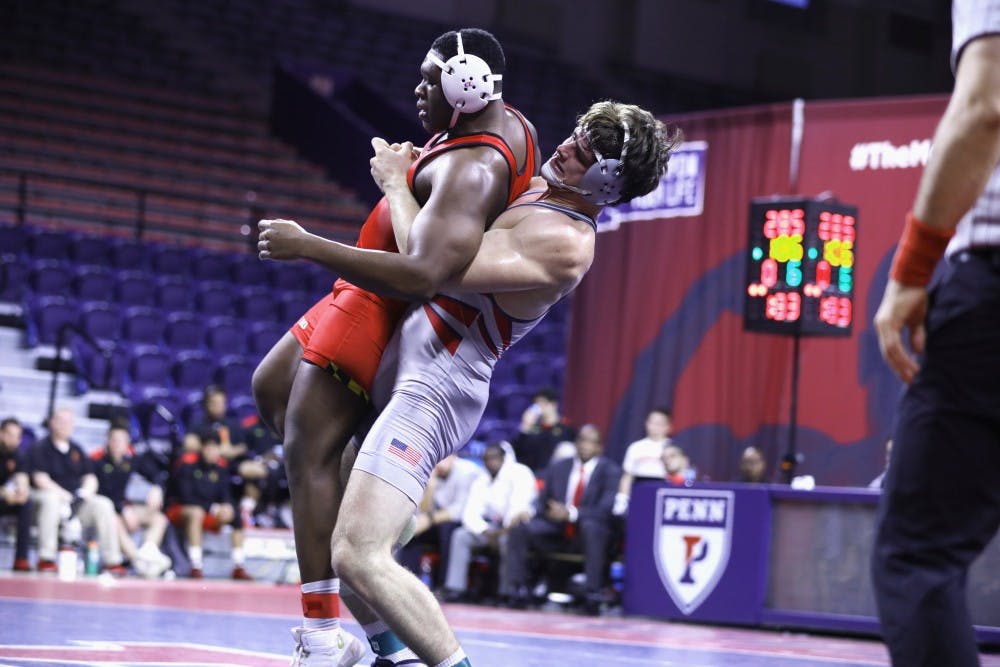If the walls could talk, oh the stories they could tell.
The Palestra has hosted more NCAA basketball games than any other college court, earning it the nickname “The Cathedral of College Basketball.” While a stop at Penn’s historic arena should be on every college basketball fan’s bucket list, it's easy to forget that the building’s history goes far beyond that sport. Three other Penn teams — volleyball, gymnastics, and wrestling — also call the venue home.
“With all the history that’s in the Palestra … you feel as if you are part of something bigger when you play there,” volleyball senior Taylor Cooper said.
These sentiments are not uncommon among Penn athletes who compete at the Palestra. And despite the fact that gymnastics splits its practice time between Rockwell Gymnasium and the Palestra, seniors Valerie Rube and Caroline Moore know where their true home is.
“There’s such a different atmosphere when you’re in the Palestra; we call it Palestra magic … we really do feel like that building is special,” Rube said.
“You walk in, and you just know that so many people before you have competed in that space … and it's just an honor to be a part of that,” Moore echoed.
While the magic of the Palestra certainly stems from the thousands of basketball games and numerous legends who have taken the floor, this rich history only serves to enhance the experience and develop a platform for Penn’s other athletes to grow.

RELATED:
Palestra court renamed following announcement of corporate sponsorship with Penn Athletics
PA announcer Richard Kahn feels right at home at the Palestra
“Even though it's mainly basketball, we can build off of that energy and history to build our own legacy,” Moore said.
By harnessing the energy of the Palestra, it's easy to see how Penn players and coaches alike feel like they have an advantage when they take the court.
“[The energy] is palpable. The Palestra really is an amazing facility … because of the history and how hard every athlete who walks in there pushes themselves,” volleyball coach Iain Braddak said.
“[The Palestra] is just some place where we all feel as if we are representing something more than ourselves," Cooper said. "The fact that you feel a greater sense of pride when you are in the Palestra gives us an advantage.”
The added energy and pressure is even something the opposition is forced to contend with when it makes the trip to Philadelphia. Braddak recalls the challenges associated with playing the Quakers at home when he faced them as an assistant coach at Columbia.
“I think it does excite our opponents," he said. "Competition is in the air … as an opponent there are definitely times when we had to coach our players through some insecurities and being intimidated by the Palestra.”
Part of the challenge or fun that comes with playing at the Palestra is the sheer size of the facility. Seating nearly 9,000, the Palestra is far bigger than every other indoor facility in the Ivy League.
“In the Palestra, you are surrounded. At other gyms they are like, ‘Let's pull out some bleachers,’ but here it's the full experience, which makes it cool for fans and for us to compete in,” Moore said.
“It's bigger than any other gym," Cooper said. "That’s part of what makes it special.”
In fact, playing in the Palestra can often mean just as much if not more to these non-basketball teams because of their complicated history with the building.
“The Palestra was once off limits to the volleyball team, and it was the early 1970s and '80s classes that worked really hard to even get to play in the Palestra," Braddak said. "Part of the history is not only playing in the Palestra but fighting to be able to use it.”
This made the reunion this season with the pioneering 1983 team even more meaningful to Braddak.
“They asked us where we practiced, and I told them we practiced at the Palestra," he said. "That was really meaningful for everyone.”

For these athletes, playing in the Palestra means leaving their own small piece that contributes to the legacy and tradition of the arena. That can come in many different ways, either in or out of competition. For Rube, this means putting her other talents on display.
“I get to sing the national anthem before our meets," she said. "Getting to do that in the Palestra where there is just so much history helps to motivate me and the team.”
Even though people may recognize the Palestra as the “Cathedral of College Basketball,” it's obvious that the other teams that play there also contribute to the history and magic of the building. At its core, the Palestra is a gathering place for members of the Penn community. No matter if the event is basketball, gymnastics, volleyball, or wrestling, the arena does its job of bringing people together, which Cooper, Moore, and Rube all stressed. When talking about the shared history of the Palestra, perhaps Braddak put it best.
“Everyone has their story. All of our alums have a different piece of it in their experience … so I don’t think anyone can ever know the true history of the Palestra.”









